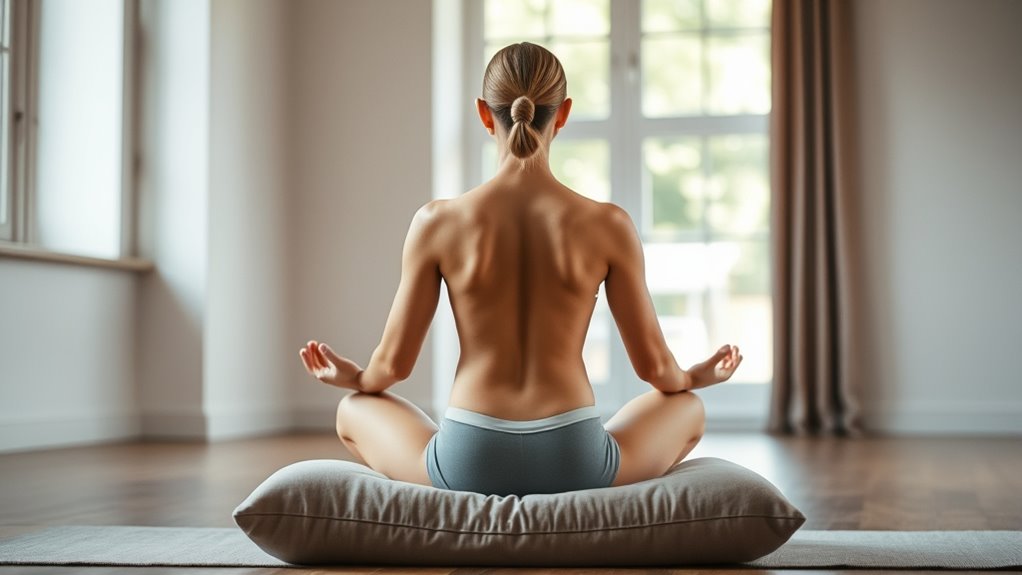To practice meditation effectively, focus on maintaining proper posture and alignment. Sit upright with your spine straight, shoulders relaxed, and head balanced naturally over your neck. Using cushions or supports can help keep you comfortable and prevent fatigue. Good posture allows your lungs to expand fully, making breathing easier and more calming. Paying attention to your body and making small adjustments can deepen your practice, and if you continue, you’ll discover how to perfect your position for greater benefits.
Key Takeaways
- Maintain an upright spine with relaxed shoulders to promote proper airflow and focus during meditation.
- Use cushions or supports to ensure comfort and alignment, preventing fatigue over time.
- Keep the head balanced naturally over the neck, avoiding tilting or slouching for optimal posture.
- Pay attention to subtle body cues and adjust positioning to alleviate tension and enhance stability.
- Proper alignment facilitates full lung expansion and diaphragmatic breathing, deepening relaxation.

Choosing the right meditation posture is essential for deepening your practice and maintaining focus. When you sit comfortably, you create a solid foundation that allows you to engage fully with your breathing techniques and stay present throughout your session. Proper alignment isn’t just about comfort; it influences your ability to breathe deeply and evenly, which is vital for effective meditation. To achieve this, consider your body’s position carefully, ensuring your spine remains upright, your shoulders are relaxed, and your head is balanced naturally over your neck. This alignment helps prevent fatigue and discomfort, making it easier to sustain your practice over time.
Proper posture enhances focus, breath, and comfort during meditation sessions.
Incorporating meditation accessories can considerably enhance your posture and overall experience. Cushions, blocks, or rolled towels can elevate your hips or support your lower back, encouraging a more natural, upright spine. For instance, a meditation cushion or zafu can help you sit comfortably on the floor without strain, especially if you find sitting cross-legged challenging. Using these accessories allows you to maintain proper alignment without tensing muscles or forcing your body into uncomfortable positions. They also help keep your hips open, which facilitates better breathing and reduces the likelihood of slouching.
Breathing techniques are deeply connected to your posture. When your body is aligned properly, your lungs have more space to expand fully, enabling deeper, more efficient breaths. Proper posture encourages diaphragmatic breathing, which calms the nervous system and enhances focus. If your shoulders are rounded or your back is hunched, you may find it harder to breathe deeply, which can distract you from your meditation. By maintaining an upright spine and relaxed shoulders, you allow your breath to flow freely, creating a sense of calm and centeredness.
Focusing on your posture also involves awareness of subtle body cues. Pay attention to how your body feels during meditation—if you notice tension or discomfort, adjust your position slightly. Small shifts, such as tilting your pelvis or relaxing your jaw, can make a meaningful difference. Remember, the goal isn’t to force an ideal posture but to find a position that supports your comfort and stability. Over time, your body will adapt, and maintaining proper alignment will become more natural, making your meditation sessions more effective and enjoyable.
Frequently Asked Questions
How Do I Choose the Best Meditation Posture for My Body?
To select the best meditation posture for your body, focus on comfort and body awareness. Sit in a position that keeps your spine straight, whether cross-legged, on a chair, or kneeling. guarantee your shoulders are relaxed, and your hands rest naturally. Listen to your body’s signals; if something feels strained or uncomfortable, adjust your posture. The right posture supports your practice and helps you stay focused and present.
What Are Common Mistakes in Maintaining Proper Alignment?
Poor posture prompts persistent breathing errors and limb misalignment. You might slump or strain, sacrificing comfort and concentration. Avoid overextending or collapsing limbs; instead, keep your spine straight and shoulders relaxed. Regularly check your alignment, ensuring your head, neck, and torso stay aligned. Mindful movements prevent mistakes, making meditation more manageable and meaningful. Remember, maintaining proper posture promotes peaceful breathing and prevents discomfort, helping you deepen your meditation practice effortlessly.
Can Meditation Posture Help Improve Overall Posture?
Yes, your meditation posture can improve your overall posture. When you maintain proper seated poses and focus on breathing techniques, you strengthen core muscles and promote spinal alignment. Regular practice encourages awareness of body tension and encourages better habits outside meditation. Over time, this mindful approach helps you develop a balanced, upright posture in daily life, reducing discomfort and preventing strain.
How Do I Adjust Posture if I Have Back Pain?
Imagine your back as a gentle river flowing smoothly; if you have back pain, try supporting your lower back with a cushion or folded blanket to ease the flow. Adjust your posture by sitting upright, engaging your core, and maintaining proper alignment. Incorporate deep breathing techniques to relax tense muscles, which helps alleviate pain. Always listen to your body, and if discomfort persists, consult a healthcare professional.
Are There Specific Postures for Different Types of Meditation?
Yes, different meditation types often have their preferred postures. For mindfulness breathing, sit comfortably with a straight back, either cross-legged or on a chair. Walking meditation involves slow, deliberate steps, focusing on each movement. Adjust your posture to stay relaxed yet alert, ensuring comfort. No matter the type, maintain proper alignment to prevent strain and deepen your focus, whether you’re sitting or walking.
Conclusion
Finding the right meditation posture is like tuning a musical instrument—you need to align each part just right to produce harmony. When I first started, I struggled, but once I found my balance, meditation became a peaceful sanctuary. Studies show that proper alignment reduces discomfort and enhances focus. Remember, your posture is the foundation for your practice. With patience and awareness, you’ll discover that sitting correctly transforms meditation into a gentle, flowing river instead of a rocky path.








